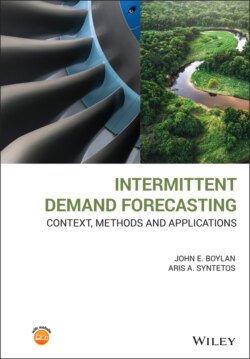Читать книгу Intermittent Demand Forecasting - John E. Boylan - Страница 2
Table of Contents
Оглавление1 Cover
2 Title Page
3 Copyright
4 Dedication
5 Preface
6 Glossary
7 About the Companion Website
8 1 Economic and Environmental Context 1.1 Introduction 1.2 Economic and Environmental Benefits 1.3 Intermittent Demand Forecasting Software 1.4 About this Book 1.5 Chapter Summary Technical Note
9 2 Inventory Management and Forecasting 2.1 Introduction 2.2 Scheduling and Forecasting 2.3 Should an Item Be Stocked at All? 2.4 Inventory Control Requirements 2.5 Overview of Stock Rules 2.6 Chapter Summary Technical Notes
10 3 Service Level Measures 3.1 Introduction 3.2 Judgemental Ordering 3.3 Aggregate Financial and Service Targets 3.4 Service Measures at SKU Level 3.5 Calculating Cycle Service Levels 3.6 Calculating Fill Rates 3.7 Setting Service Level Targets 3.8 Chapter Summary Technical Note
11 4 Demand Distributions 4.1 Introduction 4.2 Estimation of Demand Distributions 4.3 Criteria for Demand Distributions 4.4 Poisson Distribution 4.5 Poisson Demand Distribution 4.6 Incidence and Occurrence 4.7 Poisson Demand Incidence Distribution 4.8 Bernoulli Demand Occurrence Distribution 4.9 Chapter Summary Technical Notes
12 5 Compound Demand Distributions 5.1 Introduction 5.2 Compound Poisson Distributions 5.3 Stuttering Poisson Distribution 5.4 Negative Binomial Distribution 5.5 Compound Bernoulli Distributions 5.6 Compound Erlang Distributions 5.7 Differing Time Units 5.8 Chapter Summary Technical Notes
13 6 Forecasting Mean Demand 6.1 Introduction 6.2 Demand Assumptions 6.3 Single Exponential Smoothing (SES) 6.4 Croston's Critique of SES 6.5 Croston's Method 6.6 Critique of Croston's Method 6.7 Syntetos–Boylan Approximation 6.8 Aggregation for Intermittent Demand 6.9 Empirical Studies 6.10 Chapter Summary Technical Notes
14 7 Forecasting the Variance of Demand and Forecast Error 7.1 Introduction 7.2 Mean Known, Variance Unknown 7.3 Mean Unknown, Variance Unknown 7.4 Lead Time Variability 7.5 Chapter Summary Technical Notes
15 8 Inventory Settings 8.1 Introduction 8.2 Normal Demand 8.3 Poisson Demand 8.4 Compound Poisson Demand 8.5 Variable Lead Times 8.6 Chapter Summary Technical Notes
16 9 Accuracy and Its Implications 9.1 Introduction 9.2 Forecast Evaluation 9.3 Error Measures in Common Usage 9.4 Criteria for Error Measures 9.5 Mean Absolute Percentage Error and its Variants 9.6 Measures Based on the Mean Absolute Error 9.7 Measures Based on the Mean Error 9.8 Measures Based on the Mean Square Error 9.9 Accuracy of Predictive Distributions 9.10 Accuracy Implication Measures 9.11 Chapter Summary Technical Notes
17 10 Judgement, Bias, and Mean Square Error 10.1 Introduction 10.2 Judgemental Forecasting 10.3 Forecast Bias 10.4 The Components of Mean Square Error 10.5 Chapter Summary Technical Notes
18 11 Classification Methods 11.1 Introduction 11.2 Classification Schemes 11.3 ABC Classification 11.4 Extensions to the ABC Classification 11.5 Conceptual Clarifications 11.6 Classification Based on Demand Sources 11.7 Forecasting‐based Classifications 11.8 Chapter Summary Technical Notes
19 12 Maintenance and Obsolescence 12.1 Introduction 12.2 Maintenance Contexts 12.3 Causal Forecasting 12.4 Time Series Methods 12.5 Forecasting in Context 12.6 Chapter Summary Technical Notes
20 13 Non‐parametric Methods 13.1 Introduction 13.2 Empirical Distribution Functions 13.3 Non‐overlapping and Overlapping Blocks 13.4 Comparison of Approaches 13.5 Resampling Methods 13.6 Limitations of Simple Bootstrapping 13.7 Extensions to Simple Bootstrapping 13.8 Chapter Summary Technical Notes
21 14 Model‐based Methods 14.1 Introduction 14.2 Models and Methods 14.3 Integer Autoregressive Moving Average (INARMA) Models 14.4 INARMA Parameter Estimation 14.5 Identification of INARMA Models 14.6 Forecasting Using INARMA Models 14.7 Predicting the Whole Demand Distribution 14.8 State Space Models for Intermittence 14.9 Chapter Summary Technical Notes
22 15 Software for Intermittent Demand 15.1 Introduction 15.2 Taxonomy of Software 15.3 Framework for Software Evaluation 15.4 Software Features and Their Availability 15.5 Training 15.6 Forecast Support Systems 15.7 Alternative Perspectives 15.8 Way Forward 15.9 Chapter Summary Technical Note
23 ReferencesReferences
24 Author Index
25 Subject Index
26 End User License Agreement
